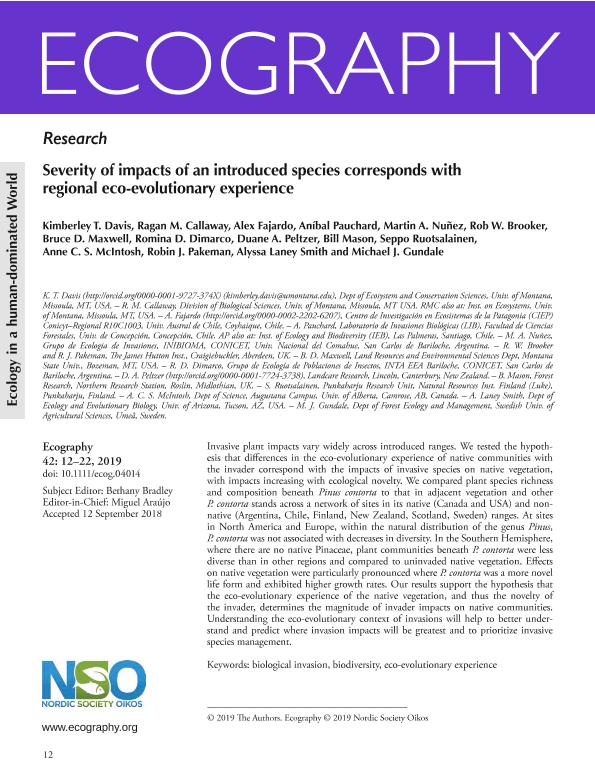Mostrar el registro sencillo del ítem
dc.contributor.author
Davis, Kimberley T.

dc.contributor.author
Callaway, Ragan
dc.contributor.author
Fajardo, Alex

dc.contributor.author
Pauchard, Aníbal
dc.contributor.author
Nuñez, Martin Andres

dc.contributor.author
Brooker, Rob
dc.contributor.author
Maxwell, Bruce
dc.contributor.author
Dimarco, Romina Daniela

dc.contributor.author
Peltzer, Duane

dc.contributor.author
Mason, Bill
dc.contributor.author
Ruotsalainen, Seppo
dc.contributor.author
McIntosh, Anne
dc.contributor.author
Pakeman, Robin
dc.contributor.author
Smith, Alyssa Laney
dc.contributor.author
Gundale, Michael
dc.date.available
2020-07-20T19:28:56Z
dc.date.issued
2019-01
dc.identifier.citation
Davis, Kimberley T.; Callaway, Ragan; Fajardo, Alex; Pauchard, Aníbal; Nuñez, Martin Andres; et al.; Severity of impacts of an introduced species corresponds with regional eco-evolutionary experience; Wiley Blackwell Publishing, Inc; Ecography; 42; 1; 1-2019; 12-22
dc.identifier.issn
0906-7590
dc.identifier.uri
http://hdl.handle.net/11336/109682
dc.description.abstract
Invasive plant impacts vary widely across introduced ranges. We tested the hypothesis that differences in the eco-evolutionary experience of native communities with the invader correspond with the impacts of invasive species on native vegetation, with impacts increasing with ecological novelty. We compared plant species richness and composition beneath Pinus contorta to that in adjacent vegetation and other P. contorta stands across a network of sites in its native (Canada and USA) and non-native (Argentina, Chile, Finland, New Zealand, Scotland, Sweden) ranges. At sites in North America and Europe, within the natural distribution of the genus Pinus, P. contorta was not associated with decreases in diversity. In the Southern Hemisphere, where there are no native Pinaceae, plant communities beneath P. contorta were less diverse than in other regions and compared to uninvaded native vegetation. Effects on native vegetation were particularly pronounced where P. contorta was a more novel life form and exhibited higher growth rates. Our results support the hypothesis that the eco-evolutionary experience of the native vegetation, and thus the novelty of the invader, determines the magnitude of invader impacts on native communities. Understanding the eco-evolutionary context of invasions will help to better understand and predict where invasion impacts will be greatest and to prioritize invasive species management.
dc.format
application/pdf
dc.language.iso
eng
dc.publisher
Wiley Blackwell Publishing, Inc

dc.rights
info:eu-repo/semantics/openAccess
dc.rights.uri
https://creativecommons.org/licenses/by/2.5/ar/
dc.subject
BIODIVERSITY
dc.subject
BIOLOGICAL INVASION
dc.subject
ECO-EVOLUTIONARY EXPERIENCE
dc.subject.classification
Ecología

dc.subject.classification
Ciencias Biológicas

dc.subject.classification
CIENCIAS NATURALES Y EXACTAS

dc.title
Severity of impacts of an introduced species corresponds with regional eco-evolutionary experience
dc.type
info:eu-repo/semantics/article
dc.type
info:ar-repo/semantics/artículo
dc.type
info:eu-repo/semantics/publishedVersion
dc.date.updated
2020-06-30T16:02:00Z
dc.identifier.eissn
1600-0587
dc.journal.volume
42
dc.journal.number
1
dc.journal.pagination
12-22
dc.journal.pais
Reino Unido

dc.journal.ciudad
Londres
dc.description.fil
Fil: Davis, Kimberley T.. University of Montana; Estados Unidos
dc.description.fil
Fil: Callaway, Ragan. University of Montana; Estados Unidos
dc.description.fil
Fil: Fajardo, Alex. Universidad Austral de Chile; Chile
dc.description.fil
Fil: Pauchard, Aníbal. Universidad de Concepción; Chile
dc.description.fil
Fil: Nuñez, Martin Andres. Consejo Nacional de Investigaciones Científicas y Técnicas. Centro Científico Tecnológico Conicet - Patagonia Norte. Instituto de Investigaciones en Biodiversidad y Medioambiente. Universidad Nacional del Comahue. Centro Regional Universidad Bariloche. Instituto de Investigaciones en Biodiversidad y Medioambiente; Argentina
dc.description.fil
Fil: Brooker, Rob. The James Hutton Institute; Reino Unido
dc.description.fil
Fil: Maxwell, Bruce. State University of Montana; Estados Unidos
dc.description.fil
Fil: Dimarco, Romina Daniela. Consejo Nacional de Investigaciones Científicas y Técnicas; Argentina. Instituto Nacional de Tecnología Agropecuaria. Centro Regional Patagonia Norte. Estación Experimental Agropecuaria San Carlos de Bariloche. Laboratorio de Ecología de Insectos; Argentina
dc.description.fil
Fil: Peltzer, Duane. Landcare Research; Nueva Zelanda
dc.description.fil
Fil: Mason, Bill. Forest Research. Northern Research Station; Reino Unido
dc.description.fil
Fil: Ruotsalainen, Seppo. Natural Resources Institute Finland; Finlandia
dc.description.fil
Fil: McIntosh, Anne. University of Alberta; Canadá
dc.description.fil
Fil: Pakeman, Robin. The James Hutton Institute; Reino Unido
dc.description.fil
Fil: Smith, Alyssa Laney. University of Arizona; Estados Unidos
dc.description.fil
Fil: Gundale, Michael. Swedish University of Agricultural Sciences; Suecia
dc.journal.title
Ecography

dc.relation.alternativeid
info:eu-repo/semantics/altIdentifier/url/https://onlinelibrary.wiley.com/doi/10.1111/ecog.04014
dc.relation.alternativeid
info:eu-repo/semantics/altIdentifier/doi/http://dx.doi.org/10.1111/ecog.04014
Archivos asociados
